- The Importance of Choosing Non-Bolting Radish Varieties
- Choosing non-bolting radish varieties is important for several reasons:
- Benefits of April Sowing for Radish
- Crimson Giant Radish
- French Breakfast Radish
- Cherry Belle Radish
- Black Spanish Round Radish
- Characteristics:
- Planting and Care:
- Uses:
- White Icicle Radish
- Daikon Radish
- Benefits of Daikon Radish:
- Tips for Growing Daikon Radish:
- Recipe Idea: Daikon Radish Salad
- Tips for Preventing Premature Flowering
- “Question-Answer”
- When is the best time to sow radish?
- What are some non-bolting radish varieties?
- What does “bolting” mean for radishes?
- How can I prevent bolting in radishes?
- Can radishes bolt if sown in April?
- What are the consequences of bolting in radishes?
- Are there any other factors to consider when sowing radishes?
- “Video” No Need To Pull Them | Bolting Veggies | Edible Radish Seed Pods | Guten Yardening
Are you tired of your radishes bolting and flowering before you have a chance to enjoy their crisp and spicy roots? If so, you’re not alone. Premature flowering, or bolting, is a common problem that can be frustrating for gardeners who are eager to harvest their radishes. However, there are some radish varieties that are less prone to bolting, making them ideal for sowing in April.
One of the best non-bolting radish varieties is the Cherry Belle. This classic red radish has a mild and slightly sweet flavor, and it matures quickly, allowing you to enjoy your harvest in just a few weeks. The Cherry Belle is known for its excellent resistance to bolting, making it a reliable choice for April sowing.
Another great option is the French Breakfast radish. This elongated radish has a crisp texture and a slightly spicy taste. It is also resistant to bolting, making it a popular choice for gardeners who want to avoid premature flowering. The French Breakfast radish is not only delicious but also adds a touch of elegance to your garden with its attractive red and white bi-color.
If you’re looking for a unique twist on the traditional radish, consider sowing the Watermelon radish. This variety is famous for its stunning pink flesh that resembles a watermelon. It has a milder flavor compared to other radish varieties and is less likely to bolt. The Watermelon radish is not only a delicious addition to salads and sandwiches but also a visually striking one.
By choosing non-bolting radish varieties for your April sowing, you can prevent premature flowering and ensure a successful harvest. Whether you prefer the classic Cherry Belle, the elegant French Breakfast, or the unique Watermelon radish, these varieties will provide you with a bountiful crop of crisp and flavorful radishes.
So, don’t let bolting radishes discourage you. With the right varieties and proper care, you can enjoy a plentiful harvest of radishes this spring!
The Importance of Choosing Non-Bolting Radish Varieties
Radishes are a popular and easy-to-grow vegetable, known for their crisp texture and spicy flavor. However, one common problem that gardeners may encounter when growing radishes is premature bolting, or the early flowering of the radish plants. This can be frustrating for gardeners, as it can impact the taste and quality of the radishes.
Bolting is a natural process triggered by environmental factors, such as high temperatures or changes in day length. When radish plants bolt, they divert their energy towards producing flowers and seeds, instead of developing large, juicy roots. This can result in radishes that are woody, tough, and bitter in taste.
Choosing non-bolting radish varieties is important for several reasons:
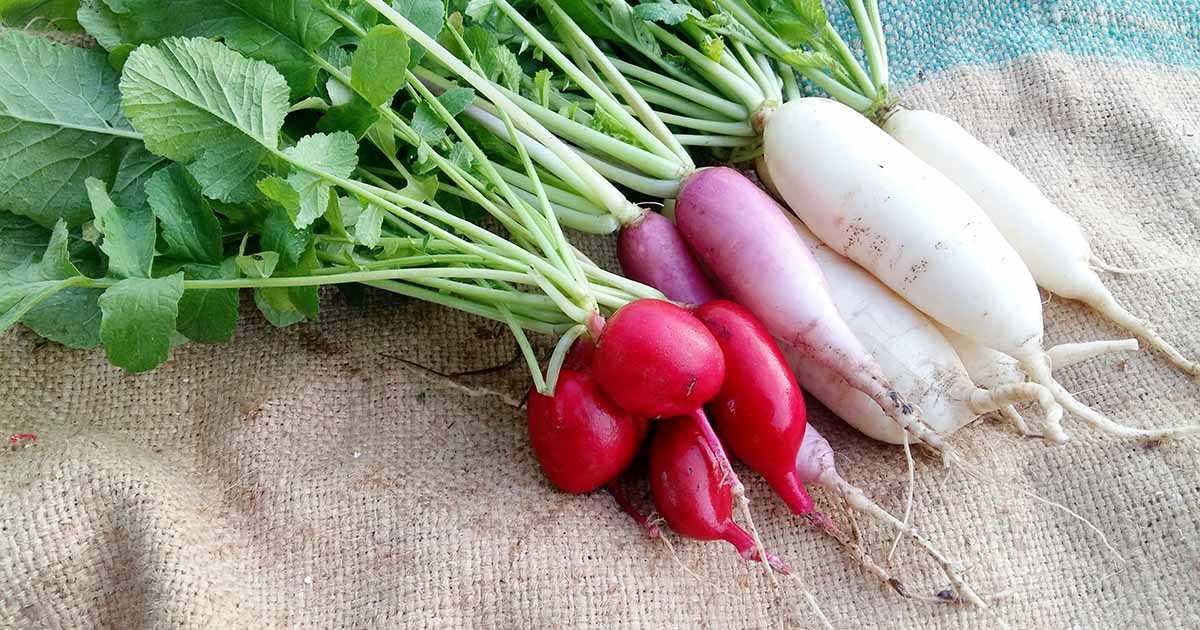
- Improved taste and quality: Non-bolting radish varieties are specifically bred to resist premature flowering. By choosing these varieties, you can ensure that your radishes develop into plump, juicy, and flavorful roots.
- Extended harvest period: Radishes that bolt early may have a shortened harvest period, as they are ready to be harvested sooner. By selecting non-bolting varieties, you can enjoy a longer harvest period and a continuous supply of fresh radishes.
- Optimal growing conditions: Non-bolting radish varieties are more adaptable to different growing conditions. They are less likely to bolt when exposed to high temperatures or changes in daylight hours. This makes them a versatile choice for gardeners in various climates.
- Easier maintenance: Radishes that bolt prematurely may require more frequent monitoring and maintenance to prevent flowering. Non-bolting varieties, on the other hand, are generally more low-maintenance and require less attention to prevent premature bolting.
When choosing non-bolting radish varieties, look for characteristics such as “slow to bolt” or “bolt-resistant” on the seed packet or plant label. Some popular non-bolting radish varieties include ‘Cherry Belle’, ‘French Breakfast’, and ‘White Icicle’.
In conclusion, selecting non-bolting radish varieties is crucial for ensuring optimal taste, extended harvest period, and easier maintenance. By choosing these varieties, you can enjoy a bountiful harvest of delicious radishes without the frustration of premature flowering.
Benefits of April Sowing for Radish
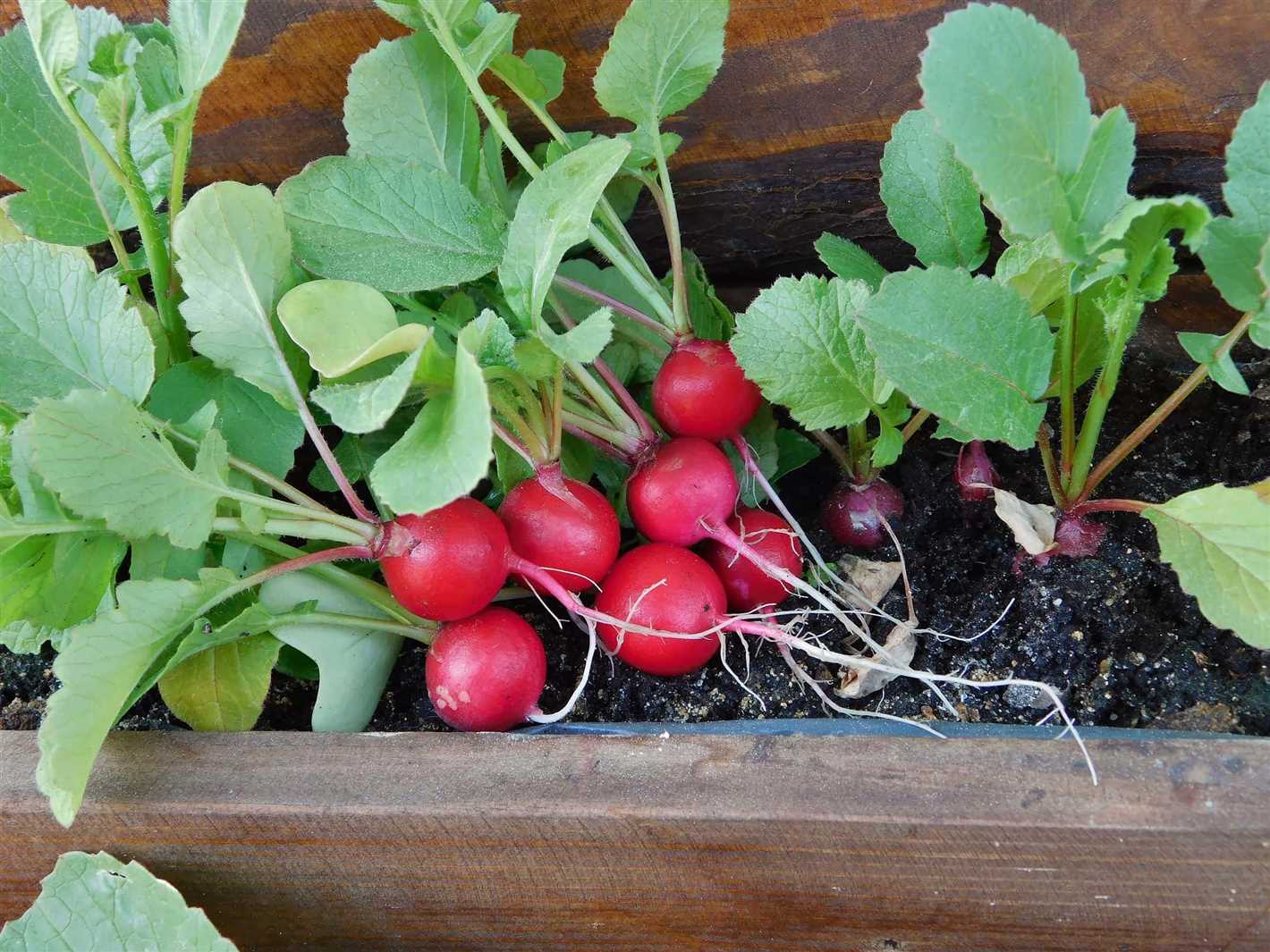
Sowing radish in April can bring several benefits, both for the plants and for the gardeners. Here are some advantages of sowing radish in April:
- Extended Growing Season: Sowing radish in April allows for an extended growing season. Radishes are cool-season crops that prefer cooler temperatures for optimal growth. By sowing in April, the radishes have more time to mature and develop before the summer heat arrives.
- Avoiding Premature Flowering: Radishes are known to bolt or prematurely start flowering when exposed to high temperatures. By sowing in April, the radishes have a better chance of avoiding premature flowering as they will have enough time to grow and mature before the heat of summer.
- Better Taste and Texture: Radishes grown in cooler temperatures generally have better taste and texture. The flavors are often more crisp and the radishes themselves are less likely to become pithy or woody. Sowing radish in April allows for the plants to grow and develop in the ideal cool conditions, resulting in tastier radishes.
- Less Pest Pressure: April is usually a time when pest pressure is lower compared to the later months of spring and summer. By sowing radish in April, you can take advantage of this period of lower pest activity and potentially have fewer issues with pests like flea beetles or root maggots.
- Succession Planting: Sowing radish in April allows for succession planting. Succession planting involves sowing a new batch of radish seeds every few weeks to ensure a continuous harvest throughout the growing season. By starting in April, you can establish the first batch of radishes and then continue to sow new seeds at regular intervals for a continuous supply.
Sowing radish in April can provide these benefits and help you grow healthy, flavorful radishes in your garden. Be sure to choose non-bolting radish varieties for the best results.
Crimson Giant Radish
The Crimson Giant Radish is a popular variety for gardeners looking for a non-bolting radish option for April sowing. It is known for its large size, vibrant red color, and crisp texture.
Characteristics:
- Size: The Crimson Giant Radish can reach sizes of up to 6 inches in diameter, making it one of the largest radish varieties available.
- Color: As its name suggests, this radish features a deep crimson-red color throughout its flesh.
- Texture: With its firm and crisp texture, the Crimson Giant Radish is perfect for adding a refreshing crunch to salads or sandwiches.
- Flavor: This variety offers a mild and slightly peppery flavor, making it enjoyable for a wide range of taste preferences.
Growing Tips:
- Sowing: Sow the seeds of the Crimson Giant Radish directly into well-prepared soil in April, ensuring a depth of around half an inch.
- Spacing: Leave about 2 inches of space between each seed to allow the radishes enough room to grow and develop.
- Watering: Keep the soil consistently moist but avoid overwatering, as this can cause the radishes to become woody or split.
- Harvesting: The Crimson Giant Radish can be harvested in approximately 30 days. Simply pull them from the ground when they reach the desired size.
Uses:
This variety of radish is versatile and can be enjoyed in various ways:
- Raw: The crisp texture and mild flavor of the Crimson Giant Radish make it a delicious addition to fresh salads.
- Pickled: The large size of this radish makes it a suitable candidate for pickling. The vibrant color adds a beautiful visual appeal to any pickled vegetable assortment.
- Cooked: While radishes are typically consumed raw, the Crimson Giant Radish can also be cooked. It can be roasted, sautéed, or stir-fried to soften its texture and mellow out its flavor.
Conclusion:
The Crimson Giant Radish is an excellent choice for gardeners who want to sow radishes in April without worrying about premature flowering. Its large size, vibrant color, and versatile uses make it a standout option for any radish lover.
French Breakfast Radish
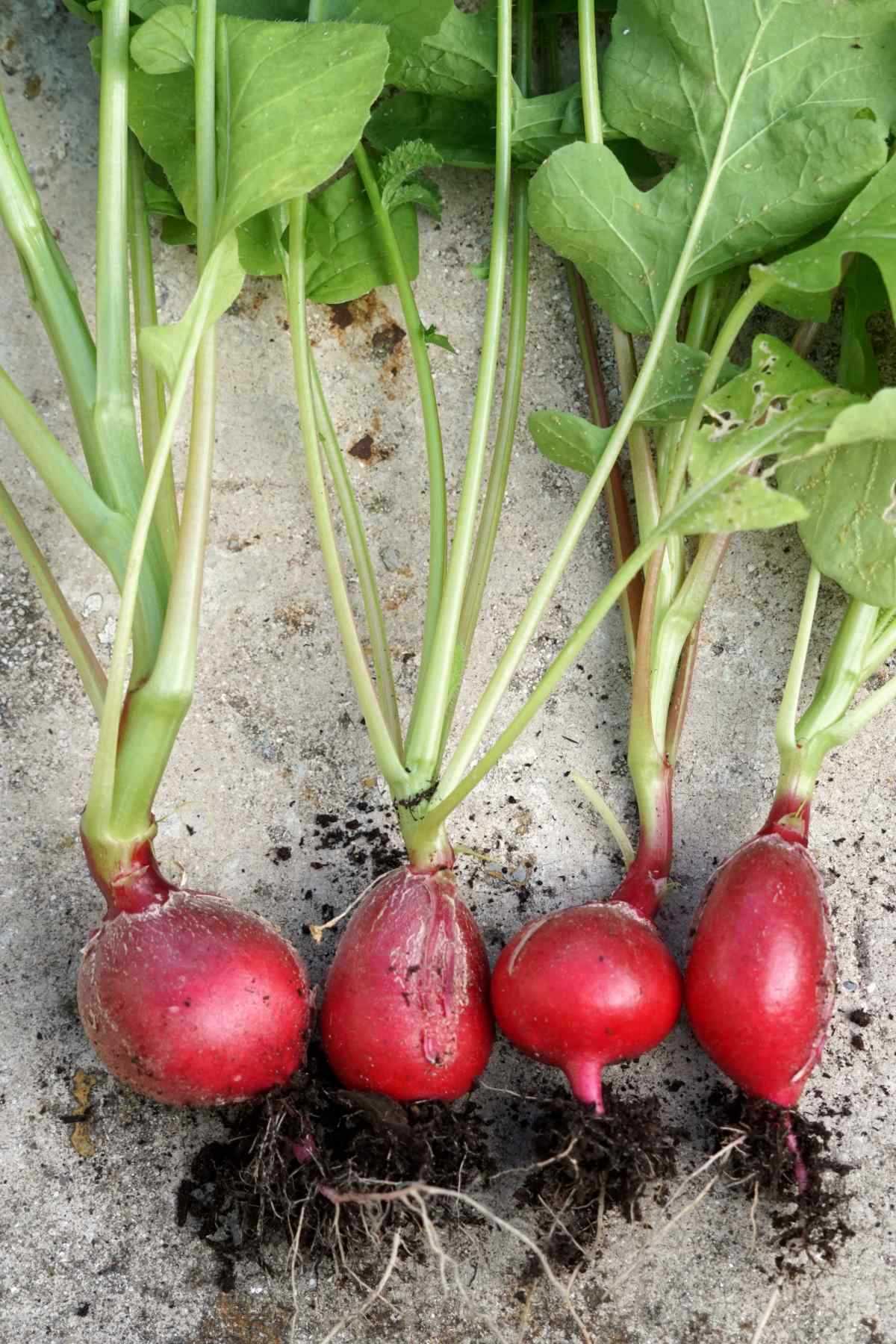
The French Breakfast radish is a popular variety known for its elongated shape and vibrant color. It is a type of radish that matures quickly and is perfect for springtime gardening.
Description:
The French Breakfast radish has an oblong shape with a pointed tip. It typically grows to a length of about 3 to 4 inches. The skin of this radish is usually bright red with a white tip, creating a beautiful contrast. The flesh is crisp and tender, offering a delightful crunch with every bite.
Growing Conditions:
The French Breakfast radish thrives in cool weather and prefers moist, well-drained soil. It can be directly sown in the garden or containers. Ensure that the soil is loose and free from rocks, as this will promote proper root development. Full sun exposure is suitable for this variety.
Care and Maintenance:
Regular watering is essential to keep the soil moist, as dry conditions may result in a bitter flavor and tough texture. Avoid overwatering, as it can cause the radishes to crack or become pithy. Weeding regularly will prevent competition for nutrients and allow your radishes to grow to their full potential.
Harvesting:
The French Breakfast radish is typically ready for harvest within 3 to 4 weeks after sowing. You can gently pull them out of the ground once they have reached the desired size. Be sure to harvest promptly to prevent the radishes from becoming tough and excessively spicy.
Uses:
The French Breakfast radish is incredibly versatile in the kitchen. Its mild flavor makes it perfect for salads, sandwiches, and as a garnish. It can be eaten raw or cooked, adding a delightful crunch and a touch of color to your dishes.
Summary:
- The French Breakfast radish is an elongated variety with a bright red skin and a white tip.
- It prefers cool weather and well-drained soil.
- Regular watering and weeding are necessary for optimal growth.
- Harvest the radishes when they have reached the desired size.
- Use them in a variety of dishes, raw or cooked.
| Characteristics | Description |
|---|---|
| Shape | Oblong with a pointed tip |
| Size | 3 to 4 inches |
| Color | Bright red with a white tip |
| Texture | Crisp and tender |
| Flavor | Mild |
Cherry Belle Radish
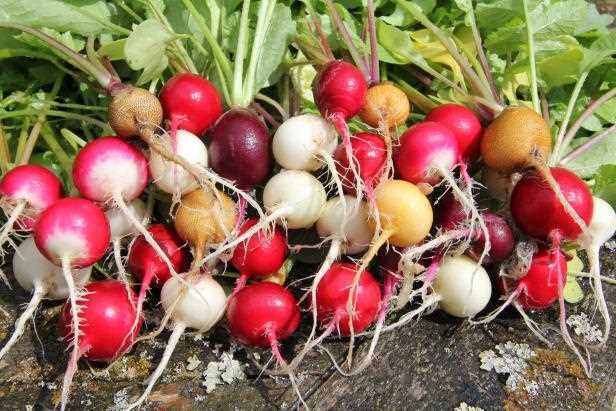
The Cherry Belle Radish is a popular variety of radish that is known for its vibrant red color and mild flavor. It is a fast-growing radish that can be harvested in as little as 22 days from sowing. This makes it a great choice for gardeners looking for a quick and easy crop.
The Cherry Belle Radish has a crisp texture and a slightly spicy taste. It is perfect for adding a pop of color and flavor to salads, sandwiches, and other dishes. The radishes are small in size, typically growing to about 1 inch in diameter, but they pack a punch in terms of flavor.
One of the great things about the Cherry Belle Radish is that it is resistant to bolting. This means that it is less likely to prematurely flower and go to seed, which can cause the radish to become tough and woody. This makes it a reliable choice for sowing in April, as the cooler temperatures help prevent bolting.
- Days to maturity: 22 days
- Planting depth: 1/2 inch
- Spacing: 1-2 inches
- Sunlight requirements: Full sun to partial shade
To sow Cherry Belle Radish seeds, prepare a well-draining soil bed and sow the seeds directly into the ground. The soil should be kept consistently moist throughout the growing season to ensure even growth. Thin out the seedlings once they have reached a few inches in height to allow for proper spacing.
Harvest the Cherry Belle Radish when they have reached the desired size, typically around 22 days after sowing. Simply pull them out of the ground by grasping the tops and gently pulling. Trim off the tops and store the radishes in the refrigerator or use them fresh in your favorite recipes.
The Cherry Belle Radish is a versatile and easy-to-grow variety that is perfect for April sowing. Its resistance to bolting makes it a reliable choice, ensuring a bountiful harvest of crisp and flavorful radishes.
Black Spanish Round Radish
The Black Spanish Round Radish is a popular variety known for its bold flavor and crisp texture. It is a winter radish that is typically sown in the fall and harvested in late winter or early spring. This radish variety is highly resistant to bolting, making it an excellent choice for April sowing.
Characteristics:
- Shape: The Black Spanish Round Radish has a spherical shape, with a smooth and glossy black skin.
- Size: This radish variety typically grows to be about 3-4 inches in diameter.
- Flavor: It has a pungent and peppery flavor, which intensifies as it matures.
- Texture: The flesh of the Black Spanish Round Radish is white, crispy, and tender.
- Growing Conditions: This variety prefers cool weather and full sun, but it can also tolerate partial shade. It requires well-drained soil with a pH level of 6.0-7.0.
Planting and Care:
- Prepare the soil by removing any rocks or debris and adding organic matter to improve its fertility.
- Direct sow the Black Spanish Round Radish seeds in April, spacing them about 1 inch apart and sowing them at a depth of ½ inch.
- Water the radish seeds thoroughly after sowing, and keep the soil evenly moist throughout the growing season.
- Thin the seedlings when they reach about 1-2 inches in height, leaving about 2-3 inches of space between each plant.
- Weed the radish bed regularly to prevent competition for nutrients and water.
- Harvest the Black Spanish Round Radish when they reach their full size, usually around 50-60 days after sowing.
Uses:
The Black Spanish Round Radish is a versatile vegetable that can be enjoyed in a variety of ways. It can be eaten raw, added to salads for a peppery kick, or used as a crunchy topping for tacos and sandwiches. It can also be pickled or roasted for a unique and flavorful side dish.
| Advantages | Disadvantages |
|---|---|
|
|
White Icicle Radish
The White Icicle Radish is a popular variety for April sowing as it is known for its non-bolting characteristic, which means it is less likely to prematurely flower and go to seed. Here are some key features of the White Icicle Radish:
- Shape: As the name suggests, the White Icicle Radish has a long and tapered shape, similar to an icicle. This shape makes it easy to harvest and adds an elegant touch to your garden.
- Color: The Radish has a crisp and white flesh, while the skin is a vibrant, glossy white color. Its contrasting colors make it visually appealing and attractive to include in salads or as a garnish.
- Flavor: With a mild and slightly peppery taste, the White Icicle Radish is both refreshing and enjoyable to consume. Its flavor complements various dishes and can add a tangy crunch to your meals.
- Growth Time: This type of Radish is known for its quick maturity, with an average growth time of around 25 to 30 days. This makes it an ideal choice for gardeners who want to enjoy a fresh harvest within a short time frame.
- Resistance: The White Icicle Radish is known for being resistant to various diseases and pests, making it a hardy and low-maintenance choice for gardeners of all levels of experience.
Overall, the White Icicle Radish is a fantastic option for April sowing, providing a delicious and visually appealing addition to your garden or recipes. Its non-bolting characteristic ensures that you can enjoy the crisp and flavorful radishes without worrying about them prematurely flowering.
Daikon Radish
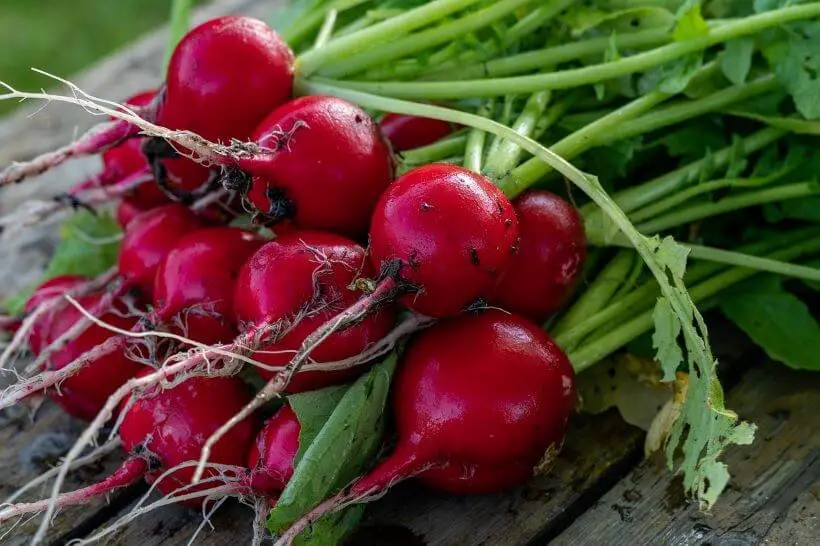
The daikon radish, also known as the Japanese radish, is a popular variety of radish that is often used in Asian cuisine. It is grown for its large, long white root that can reach up to 3 feet in length.
Daikon radish is known for its crisp texture and mild, slightly sweet flavor. It is often eaten raw in salads or used as a garnish for dishes such as sushi. It can also be cooked in stir-fries, soups, or pickled for a tangy side dish.
One of the advantages of daikon radish is its ability to grow in various climates. It can be sown in April and harvested within a few weeks, making it a great option for a quick and easy crop. It is also a non-bolting variety, which means it is not prone to premature flowering.
When sowing daikon radish, it is important to choose a sunny spot with well-draining soil. The seeds should be planted about half an inch deep and spaced about 2 inches apart. Regular watering is necessary to ensure proper root development.
Daikon radish can be harvested when the roots are large enough to eat, usually within 40-60 days after sowing. The roots should be pulled out gently to avoid any damage. They can be stored in a cool, dry place for a few weeks.
Benefits of Daikon Radish:
- Rich in vitamins C, A, and E
- High in fiber and low in calories
- Contains antioxidants that may help reduce inflammation
- Supports digestion and detoxification
- May have antibacterial properties
Tips for Growing Daikon Radish:
- Choose a sunny location with well-draining soil
- Plant seeds half an inch deep and 2 inches apart
- Water regularly to ensure proper root development
- Harvest when roots are large enough to eat, usually within 40-60 days
- Store harvested roots in a cool, dry place
Recipe Idea: Daikon Radish Salad
Ingredients:
- 1 daikon radish, peeled and thinly sliced
- 1 carrot, peeled and thinly sliced
- 1 tablespoon rice vinegar
- 1 tablespoon soy sauce
- 1 teaspoon sesame oil
- 1 teaspoon honey
- 1 tablespoon sesame seeds, toasted
- Fresh cilantro leaves, for garnish
Instructions:
- In a bowl, combine the daikon radish and carrot slices.
- In a separate bowl, whisk together the rice vinegar, soy sauce, sesame oil, and honey.
- Pour the dressing over the daikon radish and carrot slices, and toss to coat.
- Sprinkle with toasted sesame seeds and garnish with fresh cilantro leaves.
- Serve chilled and enjoy!
Daikon radish is a versatile and nutritious vegetable that can be easily grown in your garden. Whether you use it in salads, stir-fries, or pickles, it adds a delicious crunch and flavor to your dishes.
Tips for Preventing Premature Flowering
Premature flowering in radishes can lead to bitter and woody-tasting roots. To prevent this, here are some tips:
- Choose appropriate varieties: Select non-bolting radish varieties specifically bred for late sowing and resistance to premature flowering. Look for varieties known for their slow bolt rate.
- Plant at the right time: Sow radish seeds in the cooler months, preferably in early spring or late fall. Radishes thrive in cool temperatures and are less likely to bolt when planted during these times.
- Provide shade: If you’re sowing radishes during the warmer months, consider providing some shade to protect the plants from excessive heat. This can be done using shade cloths or by planting radishes near taller plants that provide shade.
- Water regularly: Radishes need consistent moisture to grow properly. Keep the soil evenly moist, especially during dry periods. Avoid overwatering, as excessively wet soil can lead to rotting.
- Use proper spacing: Avoid overcrowding the radish plants. Plant them at the recommended spacing to allow for good air circulation. Adequate spacing helps prevent stress and reduces the chances of early flowering.
- Monitor for pests and diseases: Regularly inspect your radish plants for any signs of pests or diseases. Treat any issues promptly to prevent stress and premature flowering.
- Harvest on time: Radishes should be harvested at the right stage of maturity. Delaying the harvest can signal the plant to start flowering. Harvest the radishes as soon as they reach the desired size to prevent premature flowering.
By following these tips, you can help prevent premature flowering in your radish plants and enjoy delicious, high-quality roots.
“Question-Answer”
When is the best time to sow radish?
The best time to sow radish is in April.
What are some non-bolting radish varieties?
Some non-bolting radish varieties include Cherry Belle, French Breakfast, and White Icicle.
What does “bolting” mean for radishes?
“Bolting” refers to the premature flowering of radishes, which causes the roots to become tough and woody.
How can I prevent bolting in radishes?
To prevent bolting in radishes, it is important to choose non-bolting varieties and sow them at the appropriate time. It is also crucial to provide consistent moisture and avoid high temperatures.
Can radishes bolt if sown in April?
Yes, radishes can still bolt if sown in April if the weather conditions are unfavorable, such as high temperatures or inconsistent moisture.
What are the consequences of bolting in radishes?
The consequences of bolting in radishes are that the roots become tough and woody, making them less enjoyable to eat and more difficult to harvest.
Are there any other factors to consider when sowing radishes?
Yes, besides choosing non-bolting varieties and sowing at the right time, it is important to prepare the soil properly and thin the seedlings to ensure proper growth and development.







